Physical Address
304 North Cardinal St.
Dorchester Center, MA 02124
Physical Address
304 North Cardinal St.
Dorchester Center, MA 02124
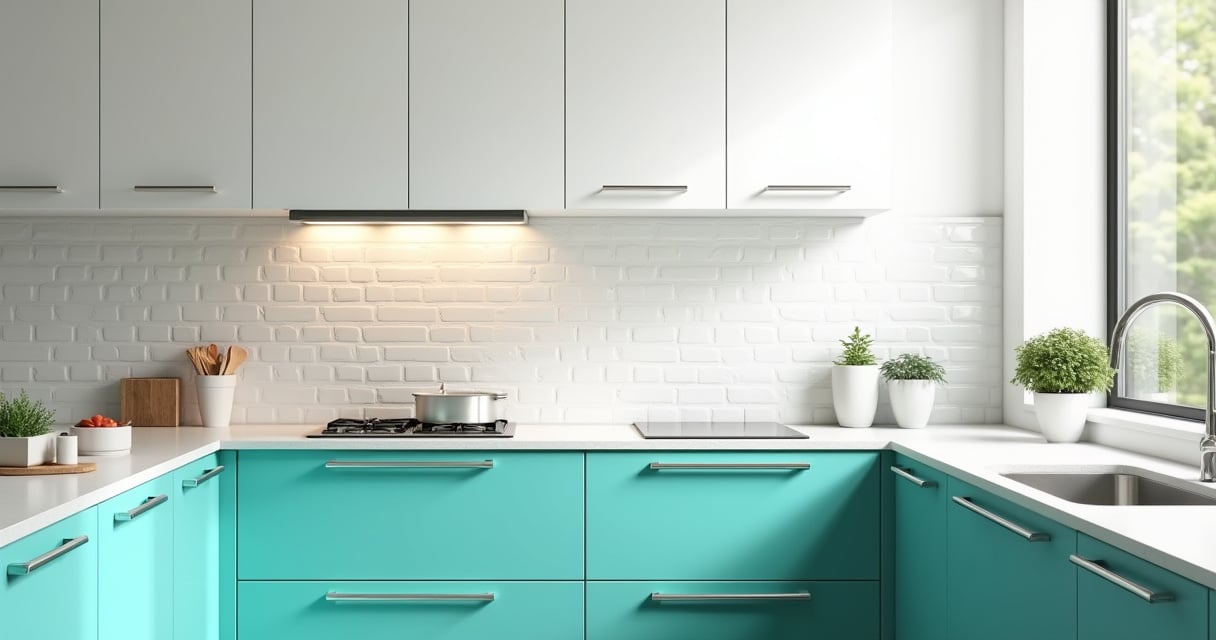
The kitchen is more than just a place to cook. It's the heart of the home where we gather, create, and live our daily lives. At the core of every functional kitchen lies its cabinetry - not merely storage solutions, but the backbone of your kitchen's design.
The kitchen is more than just a place to cook. It’s the heart of the home where we gather, create, and live our daily lives. At the core of every functional kitchen lies its cabinetry – not merely storage solutions, but the backbone of your kitchen’s design.
Whether you’re planning a full renovation or just refreshing your space, understanding cabinet design possibilities is key to unlocking your kitchen’s potential. Ready to transform your cooking space into something you truly love? Let’s explore these 24 genius kitchen cabinet design ideas that will inspire your next project.
What keeps Shaker cabinets consistently topping kitchen design charts? Their enduring appeal stems from simplicity and versatility. Recognized by clean lines and five-piece construction with a flat recessed center panel framed by four rails, Shaker cabinets embody understated beauty and practicality. The simple mortise and tenon joinery exemplifies the Shaker commitment to craftsmanship without unnecessary ornamentation.
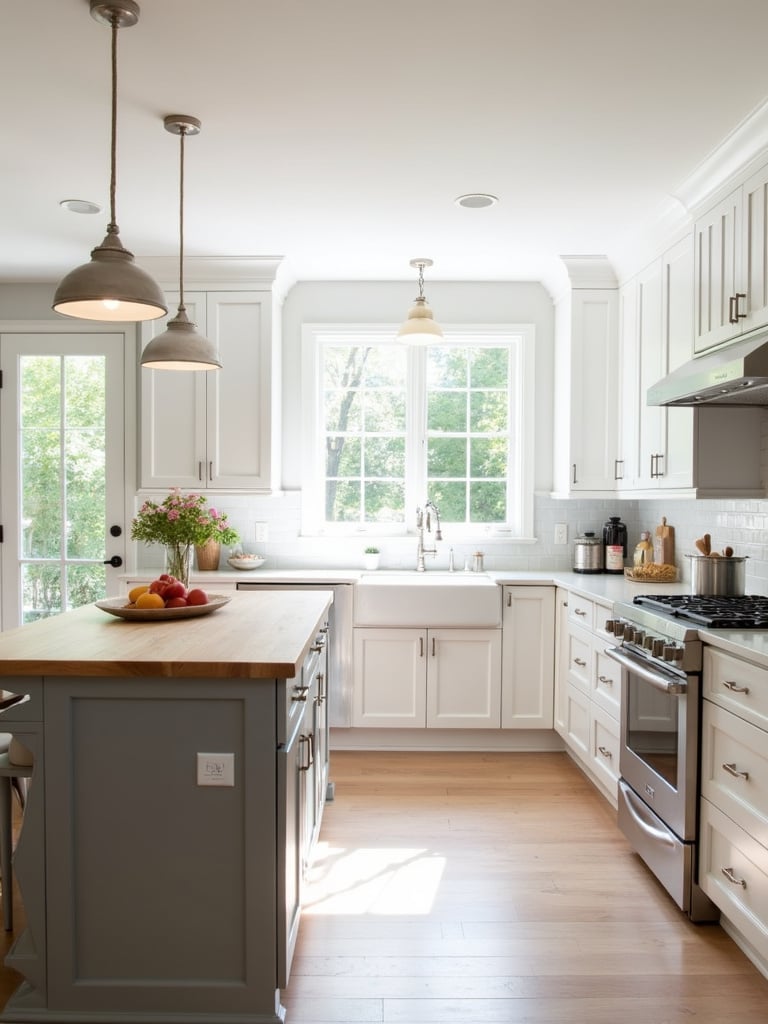
Shaker cabinets adapt effortlessly to various kitchen styles – from traditional warmth to modern sleekness and even rustic Farmhouse charm. Unlike trend-driven designs that quickly become dated, they provide a lasting foundation that remains stylish year after year. This adaptability makes updating your kitchen simple; changing hardware, countertops, or backsplash can give your kitchen a fresh look without replacing cabinets.
Here’s the catch – while Shaker cabinets look simple, achieving authentic Shaker style requires attention to detail, particularly ensuring the stiles and rails of the cabinet frame are the same width.
For those drawn to clean, uncluttered aesthetics, slab cabinet doors are the quintessential choice. Unlike traditional framed options, slab doors feature completely flat, frameless construction – essentially a single, solid piece without ornamentation, raised panels, or molding. This stark minimalism defines modern design, emphasizing simplicity and clean lines. The beauty lies in their unadorned nature, allowing the material and color to take center stage.

Your material selection plays a crucial role in achieving the desired modern look. Wood veneer offers natural warmth at an accessible price. Laminate provides durability with diverse color options. Thermofoil delivers a seamless, easy-to-clean surface. Acrylic creates a high-gloss, glass-like finish. For luxury, solid hardwoods like maple or walnut make a statement. And for industrial edge, metal slab cabinets in stainless steel or aluminum offer bold durability.
Let me paint you a picture – to achieve a truly seamless modern kitchen, consider using touch-latch hardware that allows you to open cabinets without visible handles, creating an ultra-clean aesthetic that’s both functional and striking.
If you yearn for a kitchen brimming with warmth, comfort, and nostalgia, beadboard cabinetry might be your perfect match. Distinguished by vertical, narrow planks separated by delicate, rounded “bead” details, this design creates subtly textured surfaces that add visual interest. Historically a readily available material in rural homes, beadboard instantly evokes simplicity and unpretentious elegance. Its textured surface cleverly conceals minor imperfections – perfect for character-rich homes.
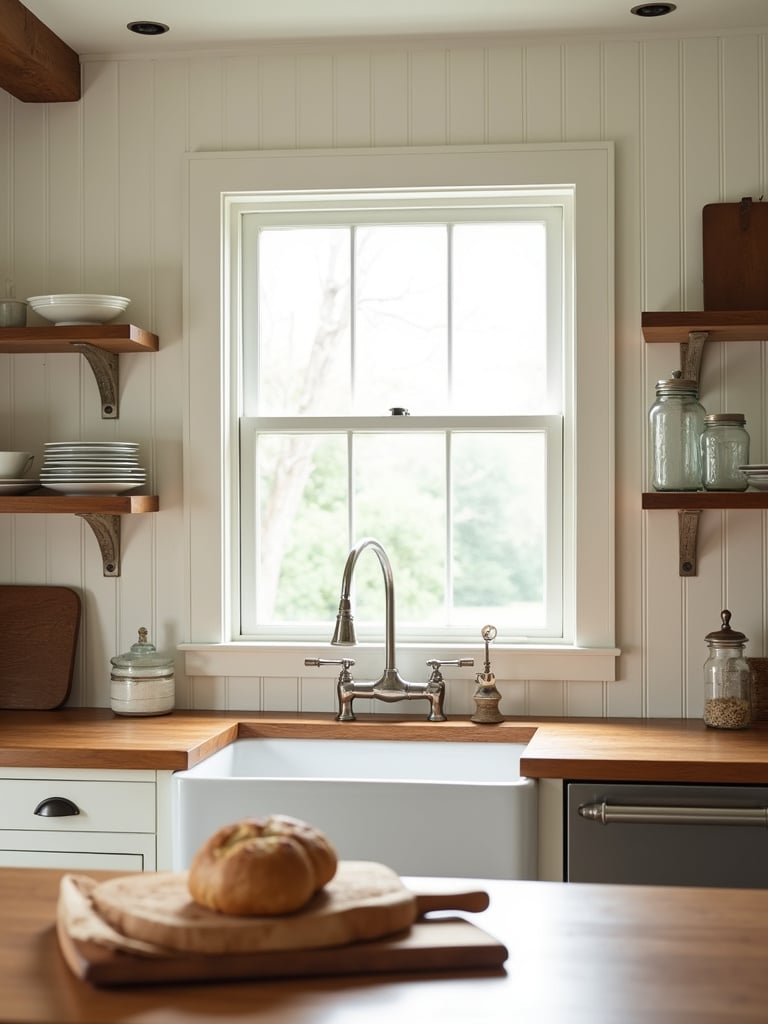
Color palettes for farmhouse beadboard cabinetry typically feature soft, muted tones that enhance tranquility. While classic white remains popular, consider exploring:
For added boldness, deeper shades like navy or warm charcoal can add sophistication while maintaining farmhouse spirit. Distressed Finishes or subtle glazing techniques amplify the authentic, timeworn character that makes this kitchen cabinet design so appealing.
The game-changer happened as I experimented with two-tone beadboard cabinets – painting base cabinets in a darker shade and upper cabinets in a lighter tone creates visual interest while maintaining cohesive farmhouse charm.
In a world dominated by painted surfaces and manufactured materials, Natural Wood Cabinets offer unparalleled organic warmth. Each wood piece showcases unique grain patterns and natural variations that manufactured materials simply can’t replicate. Beyond aesthetics, wood provides remarkable durability – unlike painted or laminate surfaces that chip or peel, wood can be refinished if damaged. Natural wood possesses timeless appeal that complements diverse kitchen styles, from rustic to surprisingly contemporary.
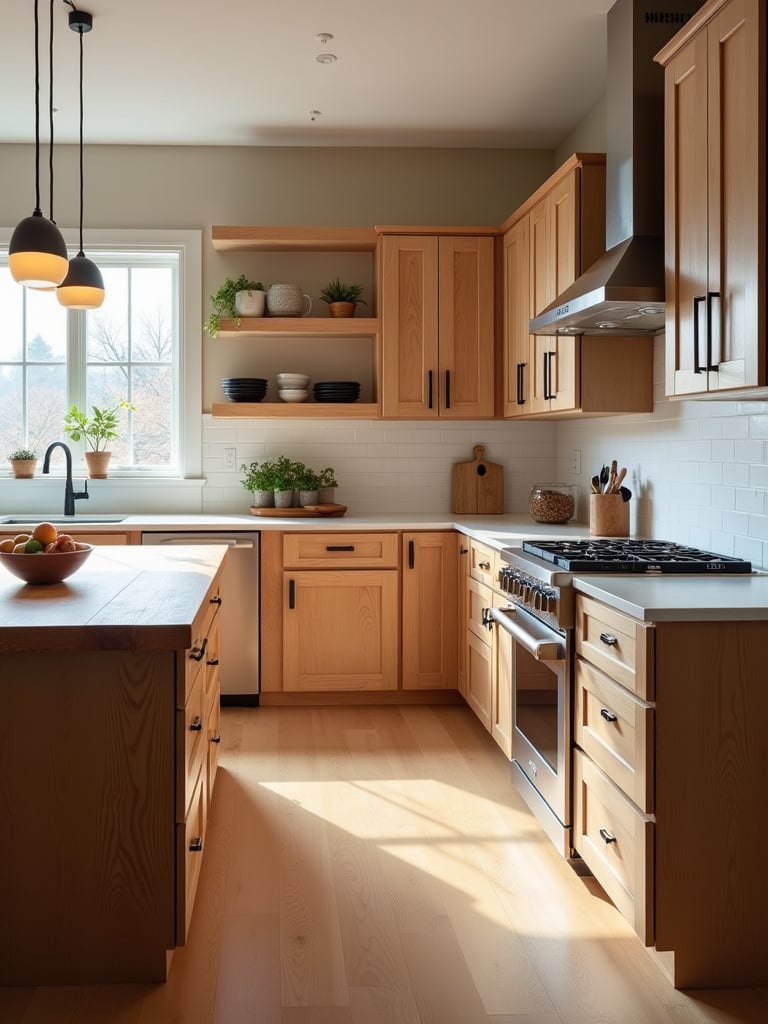
The wood species spectrum offers rich options for kitchen cabinet design, each with distinct personality:
Think of it as choosing a personality for your kitchen – oak makes a bold statement, maple whispers sophistication, cherry exudes warmth, walnut speaks of luxury, hickory tells stories of durability, and alder offers approachable elegance.
What complicates this choice is that wood color changes over time due to oxidation and sunlight exposure. This “patina” is often desirable, but test your chosen finish on a sample piece to understand how it will evolve with your specific wood species.
White kitchen cabinets have dominated design for decades with good reason. Their enduring appeal lies in versatility, timelessness, and ability to create bright atmospheres. White cabinets naturally reflect light, making smaller kitchens feel spacious and inviting. They serve as blank canvases for easy style updates through hardware, backsplash, and countertop changes. Most importantly, white cabinets harmonize with virtually any color scheme and design aesthetic.
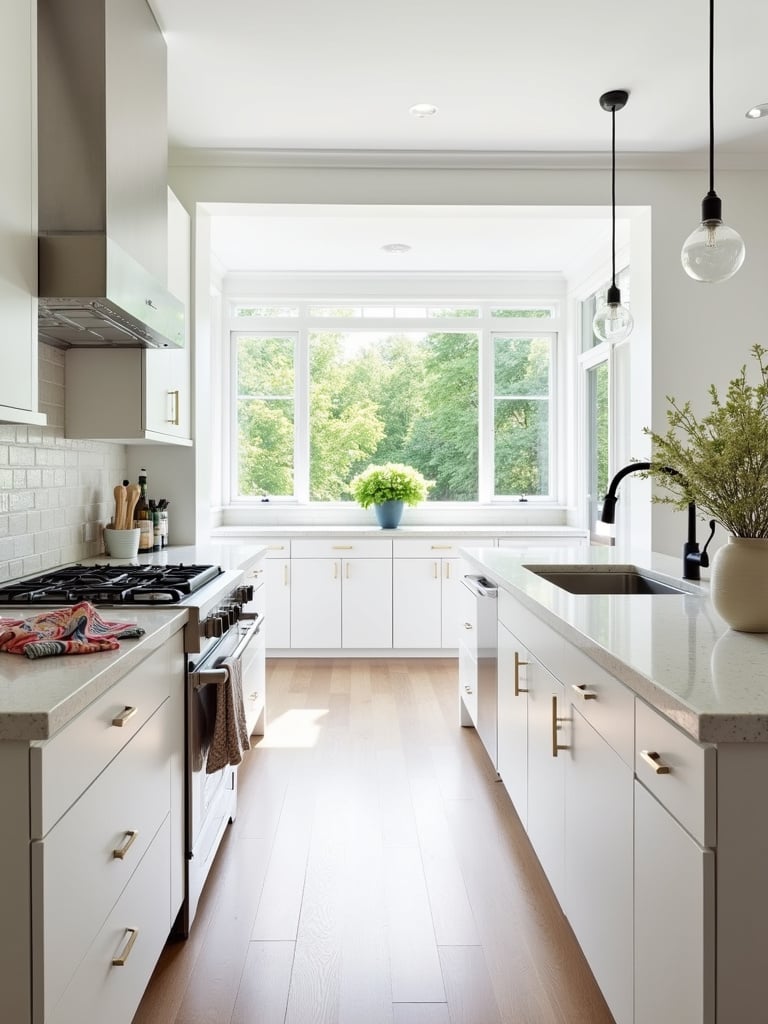
While seemingly simple, white encompasses a spectrum of shades and finishes that influence your kitchen’s feel. Bright white creates clean, contemporary statements. Off-white or cream tones infuse warmth and traditional ambiance. Finishes further define the look – glossy finishes amplify light reflection for modern designs, while matte finishes offer softer looks favored in farmhouse or transitional kitchens. Consider undertones carefully: cool undertones (bluish) pair with grays or blues, while warm undertones (yellowish) complement warmer palettes and wood tones.
My breakthrough came when I realized the right white isn’t universal – it depends entirely on your kitchen’s lighting. Test samples under different conditions throughout the day to see how colors shift from morning brightness to evening warmth before committing.
Grey has emerged as a dominant force in kitchen cabinet design, and for good reason. This sophisticated neutral effortlessly complements styles from ultra-modern minimalist to traditional farmhouse. Its timeless quality ensures longevity beyond passing trends. Grey allows other elements – striking countertops, eye-catching backsplashes, statement appliances – to shine against its understated elegance. Practically speaking, grey also conceals everyday dirt and smudges better than stark white, making it forgiving for busy family kitchens.
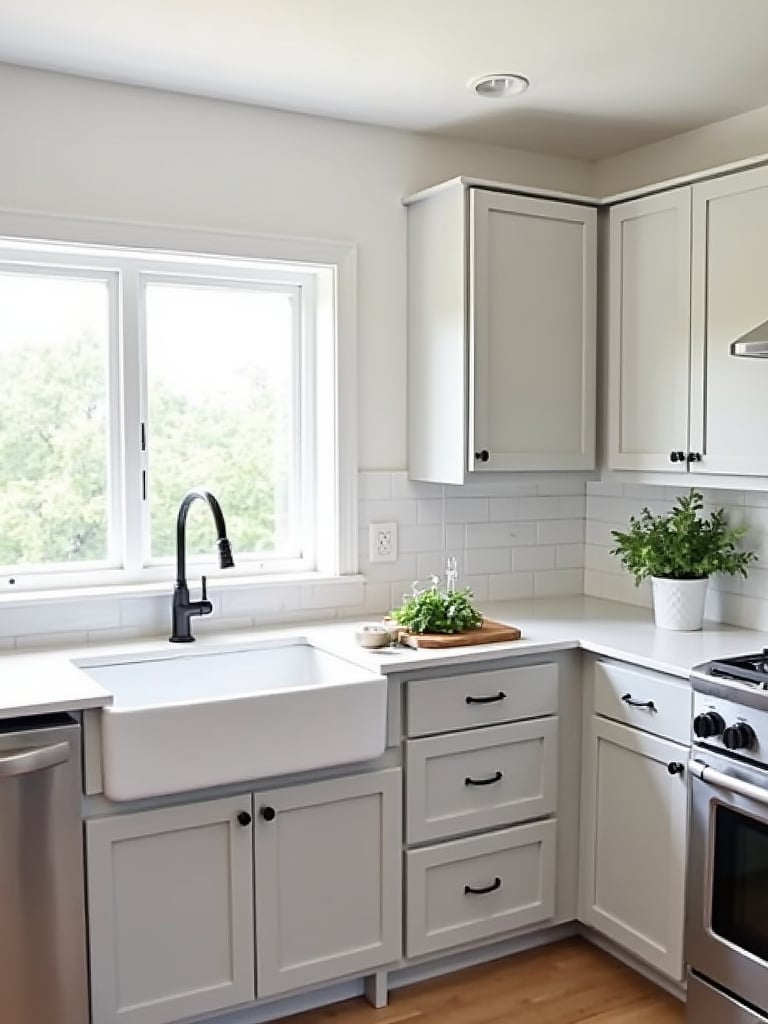
The beauty of grey lies in its nuanced spectrum, each shade creating a distinct atmosphere:
Beyond shade, consider undertones carefully. Cool greys with blue/green undertones project modern cleanliness. Warm greys with brown/red undertones add inviting coziness. The right grey depends on your existing elements and desired feeling.
The missing piece is lighting consideration – natural light washes out colors, so darker grey might work better in sun-filled kitchens, while lighter grey maximizes brightness in darker spaces.
For those seeking to inject personality into their kitchen, vibrant colored cabinets are transformative. Bold colors dramatically convert ordinary kitchens into extraordinary spaces that reflect your unique style. They energize smaller kitchens, making them dynamic, or warm larger kitchens, making them intimate. Strategic color placement can highlight architectural features or create striking contrasts with neutral elements.
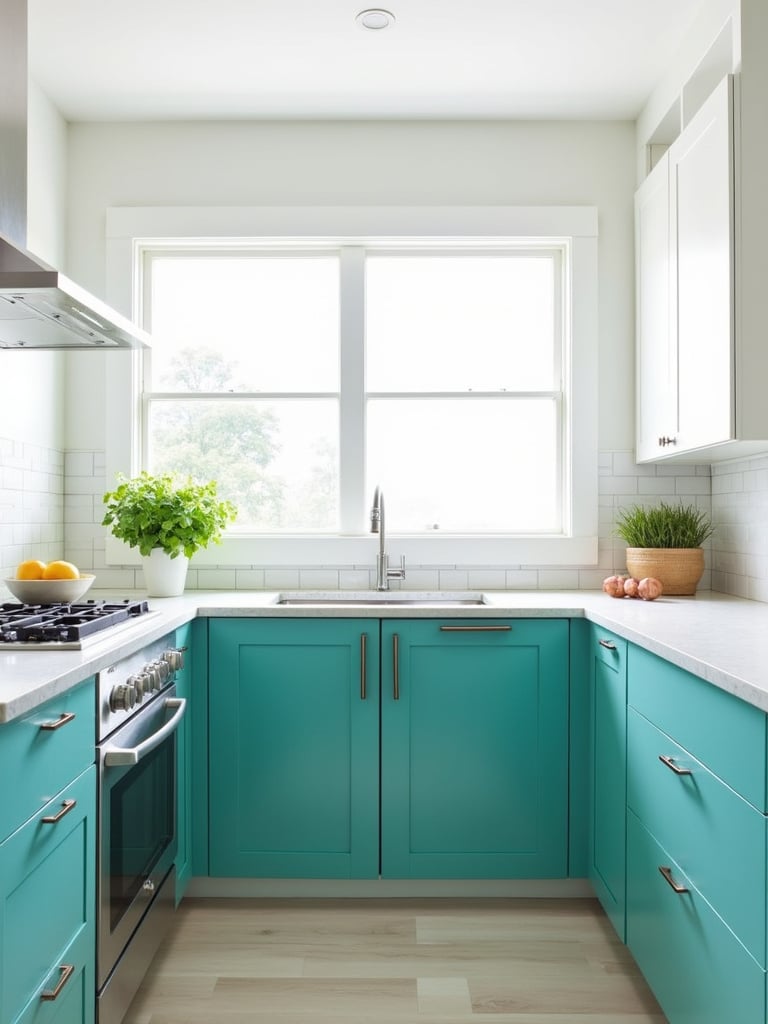
When exploring vibrant cabinet colors, consider these exciting possibilities:
“Color is a power that directly influences the soul.” – Wassily Kandinsky
This wisdom applies perfectly to kitchen cabinet design – the right vibrant color doesn’t just change how your kitchen looks, but how it feels to be in it.
The tricky part is commitment – before embracing bold color, paint a large sample board and observe it throughout the day in different lighting conditions. What looks perfect in morning light might feel overwhelming by evening.
Beyond aesthetics, kitchen cabinets fundamentally provide storage. Standard shelving often leads to disorganization and wasted space – this is where cabinet inserts become essential. These transformative additions convert disorganized, underutilized cabinet space into highly functional storage zones. They provide dedicated places for specific items, preventing clutter, improving accessibility, and maximizing both vertical and horizontal space. Without clever inserts, cabinets often become chaotic jumbles leading to wasted space and inefficient workflow.

The world of cabinet inserts offers solutions for every storage need:
The stumbling block is measurement – before purchasing any inserts, thoroughly measure cabinet interiors, including width, depth, and height. Consider obstructions like pipes or hinges that might affect installation.
Pull-out kitchen drawers take accessibility to new levels, particularly in pantries and base cabinets. They eliminate the frustrating “black hole” effect of deep shelves, making items at the back easily visible and reachable. They maximize vertical space by enabling neat stacking and preventing items from getting lost. Most importantly, they improve ergonomics by eliminating the need to bend and reach deeply into cabinets – especially beneficial for those with mobility limitations.

Pull-out drawers come in several types tailored to different needs:
When selecting pull-out drawers for your kitchen cabinet design, carefully consider weight capacity and materials based on intended contents. Wood, metal, or combination construction each offer different benefits for specific storage needs.
Do you see how huge that is? Imagine never having to empty half your cabinet to reach something at the back again. That’s the life-changing magic of well-designed pull-out drawers.
The debate between open shelving and closed cabinets remains central to kitchen design. Open shelving creates airy, spacious feels that visually expand kitchens and prevent boxed-in sensations. It showcases beautiful dishware and decorative items, adding personality and character. Items remain easily accessible, with everyday essentials readily at hand. For budget-conscious renovators, open shelving often costs less than traditional upper cabinets.
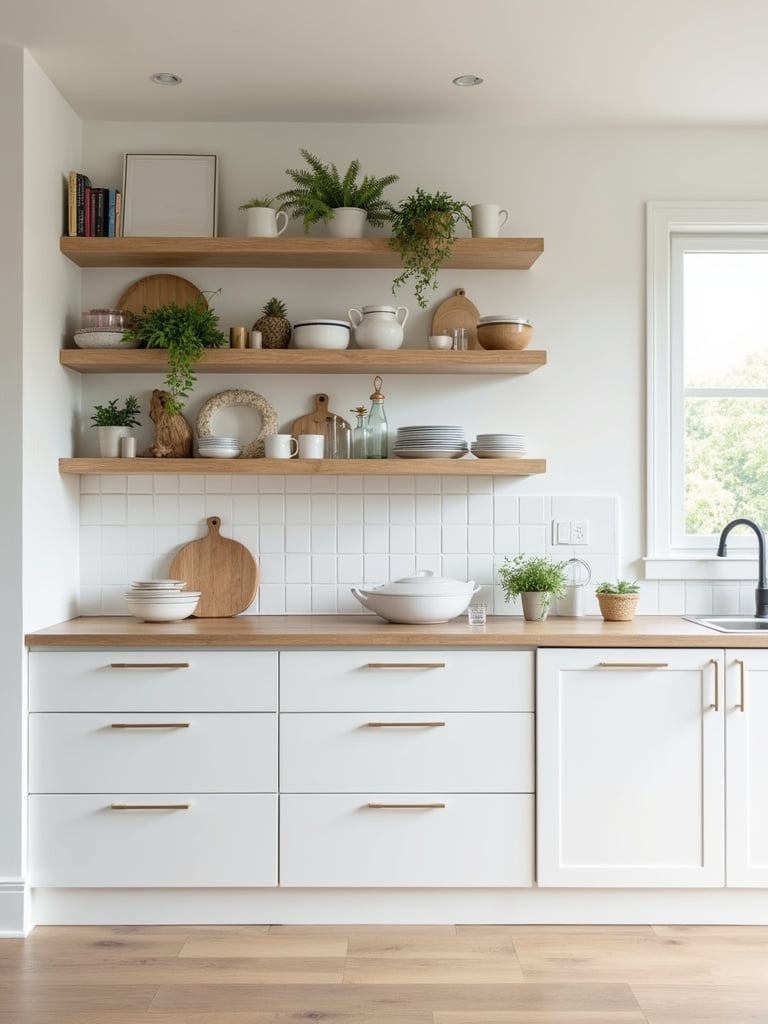
Conversely, closed cabinets excel at concealing clutter, maintaining clean, streamlined appearances. They protect stored items from dust, grease, and cooking splatters – crucial for less frequently used items. Closed cabinets generally provide more enclosed storage volume for bulky appliances and pantry staples not suited for display. They contribute to uniform, traditional aesthetics with a sense of order and classic design.
The heart of the matter is finding your perfect balance. Consider a mixed approach – perhaps open shelving for frequently used, attractive items near the coffee station, with closed cabinets for bulkier, less display-worthy necessities. This hybrid approach often delivers the best of both worlds.
Hardware – knobs and pulls – acts as jewelry for cabinetry, defining style and functionality. Scale is paramount in selection! For smaller cabinets under 18 inches wide, choose knobs or pulls with 3-4 inch center-to-center measurements. Medium drawers (18-36 inches) need longer pulls, ideally 5-8 inches, for visual proportion and comfortable gripping. Very large drawers over 36 inches may benefit from two pulls, evenly spaced for balanced access. Always visualize the overall look – larger hardware makes bold statements while smaller pieces offer understated elegance.

Hardware styles vary dramatically to complement different cabinet designs:
Here’s what happened when I updated just the hardware on older cabinets – the entire kitchen transformed with minimal investment. It’s like changing your jewelry to update an outfit – small change, big impact.
Countertops and cabinets dominate kitchen visuals, making their pairing crucial for cohesive design. These two elements establish the kitchen’s foundation, profoundly impacting style, mood, and perceived value. Incompatible pairings create visual disharmony and disjointed spaces, while harmonious combinations elevate the entire design with balance and sophistication.

Countertop materials offer unique characteristics for various cabinet styles:
The breakthrough came when I realized successful pairings consider not just colors but textures. Combining highly textured cabinets with busy countertops creates visual chaos, while pairing simple cabinet designs with statement countertops creates perfect balance.
Beyond style and materials, cabinet layout dictates kitchen functionality. A well-planned layout strategically minimizes steps between key work zones – cooking, cleaning, and preparation – reducing unnecessary movement and maximizing storage efficiency. This thoughtful arrangement makes cooking and cleaning more enjoyable and less stressful. Conversely, poor layouts lead to daily frustration, wasted space, inefficient workflow, and potential safety hazards.

The kitchen Work Triangle concept connects three primary areas: sink, refrigerator, and cooktop/oven. Ideally, these points form a triangle with short, unobstructed distances between them, facilitating efficient movement during meal preparation. Cabinet placement directly impacts this triangle’s efficiency – placing the refrigerator too far from the cooktop makes ingredient retrieval cumbersome. While modern kitchens often incorporate multiple work zones for multiple cooks, the triangle principle remains valuable for ensuring efficient flow and strategic cabinet placement.
Picture it this way – your kitchen should flow like a well-choreographed dance, with each step purposeful and efficient. The right cabinet layout creates the stage for this daily performance.
Concealing appliances behind cabinetry panels has become popular for clean, uncluttered kitchens. This integration creates visually cohesive, uncluttered spaces that promote minimalist aesthetics. It allows unified, harmonious design where bulky appliances blend seamlessly rather than disrupting style. This approach elevates perceived kitchen value with sophisticated refinement. In smaller kitchens, concealed appliances make spaces feel larger by minimizing visual distractions.

The most commonly concealed appliances include:
Feasibility depends on appliance size, ventilation requirements, and daily access needs. Some appliances require specific panel-ready models designed for this purpose.
My experience went like this – after integrating panels on my refrigerator and dishwasher, the kitchen instantly felt more spacious and high-end. The continuous cabinetry created a sense of calm that transformed the entire room’s feel.
Glass-front cabinets offer delightful alternatives to solid doors, adding visual interest and elegance. They visually expand kitchen space by creating openness and depth, making rooms feel larger and brighter. They perfectly showcase treasured dishware and decorative collections, adding personality and style. Glass fronts subtly improve organization by making contents visible, encouraging tidiness. They transform everyday items into focal points, adding curated charm to overall kitchen design.

Glass options for cabinet fronts vary significantly:
The surprising part is how glass-front cabinets can actually make small kitchens feel larger by breaking up solid wall cabinet runs. The visual depth they create expands the perceived space while adding character that solid cabinets simply can’t match.
The two-tone cabinet trend offers dynamic alternatives to single-color kitchens. This approach breaks away from potential monotony, highlighting specific areas like islands or upper cabinets. It adds depth and dimension while creating custom, sophisticated looks reflecting individual style. Its enduring popularity stems from versatility across kitchen styles from modern to farmhouse.

Exciting two-tone combinations include:
The key thing to understand is that two-tone cabinets aren’t just about aesthetics – they can strategically define zones in open-concept kitchens or draw attention to architectural features worth highlighting.
Proper lighting is essential in kitchens, with under-cabinet lighting providing targeted illumination. This enhancement significantly improves countertop visibility – your primary workspace. It makes food preparation, cooking, and cleaning safer, more efficient, and less straining. It eliminates shadows from overhead lighting, providing focused light exactly where needed for tasks like chopping and reading recipes. This shadow reduction dramatically improves kitchen safety when working with sharp tools.

Beyond functionality, under-cabinet lighting elevates kitchen aesthetics by:
“Lighting is the jewelry of the home. It can make or break a space.” – Interior designer Kelly Wearstler
This insight perfectly captures how under-cabinet lighting transforms kitchen cabinet design from merely functional to truly exceptional.
Let’s unpack this – installing dimmable under-cabinet lighting allows adjustment throughout the day, from bright task lighting during meal prep to soft ambient glow during evening gatherings, making your kitchen infinitely more versatile.
Kitchen islands have become coveted features in modern design, offering benefits beyond aesthetics. Islands with integrated cabinets significantly boost storage capacity for cookware and serving dishes. They increase available countertop space for food preparation, appliance placement, or buffet setups. Many designs incorporate seating, creating informal dining and socializing areas. Islands often become central focal points, enhancing overall aesthetic appeal. Well-designed islands improve workflow by creating distinct zones for various kitchen activities. They can also house essential appliances like dishwashers or wine coolers, freeing space elsewhere.

Planning an effective island requires careful consideration of:
What really matters here is thinking beyond the island as furniture and considering it as a workstation. The most successful islands integrate seamlessly into your cooking workflow rather than interrupting it.
Corner cabinets often become design afterthoughts but can transform into highly functional storage with the right solutions. These spaces are considered awkward because they’re inherently difficult to access, resulting in unusable or hard-to-reach areas deep in back corners. Reaching into traditional corner cabinets is physically challenging and frustrating. The “blind corner” design, extending far back and creating hidden, inaccessible areas, epitomizes this awkwardness. Without clever solutions, corner cabinets become neglected dumping grounds for rarely used items.

Innovative storage solutions specifically address corner cabinet challenges:
Here’s the inside story – I installed a two-tiered lazy susan in my own corner cabinet, and suddenly that formerly useless space became prime storage for pots and small appliances. The transformation was immediate and dramatic.
In space-limited kitchens, maximizing vertical storage is essential, with tall cabinets providing ultimate solutions. They significantly increase overall storage capacity compared to standard-height cabinets, providing more cubic feet within the same footprint. This vertical efficiency is crucial in smaller kitchens where maximizing every inch matters. Beyond functionality, tall cabinets create visually appealing, streamlined looks that draw eyes upward, making kitchens feel larger. They can strategically conceal less attractive items or entire appliances, contributing to cleaner, more organized aesthetics.

Tall cabinets efficiently accommodate diverse kitchen items:
The game-changer happened as I realized tall cabinets aren’t just for storage – they create architectural interest that transforms ordinary kitchens into custom-looking spaces, especially when they reach all the way to the ceiling.
Kitchen cabinets represent significant investments, making durability crucial for longevity. Solid hardwood stands as the most durable option, particularly dense varieties like maple, oak, cherry, and birch, offering exceptional strength and lasting beauty. High-quality plywood with hardwood veneer achieves excellent durability and dimensional stability, often proving more stable than solid wood in fluctuating humidity. Thermofoil provides durable, water-resistant surfaces, though it can suffer heat damage. For ultimate durability, stainless steel cabinets offer exceptional robustness for high-end kitchens.

Humidity significantly impacts cabinet performance over time:
The crucial element is balance – incorporating mixed materials like durable plywood for cabinet boxes with solid wood doors and drawer fronts optimizes both cost and longevity. This hybrid approach delivers the best performance for most kitchen environments.
Creating environmentally conscious kitchens has become increasingly important, with eco-friendly cabinet materials readily available. Popular sustainable options include reclaimed wood salvaged from older buildings, offering unique rustic aesthetics while reducing deforestation. Bamboo, a rapidly renewable grass, provides incredible sustainability, growing much faster than trees. FSC-certified wood ensures responsible forest management. Recycled wood fibers create MDF or particleboard, minimizing waste. Agricultural fibers like wheatboard utilize byproducts, offering low-VOC alternatives to traditional wood.

Choosing eco-friendly cabinets delivers significant benefits:
“We don’t inherit the earth from our ancestors; we borrow it from our children.” – Native American proverb
This perspective perfectly captures why sustainable kitchen cabinet design matters – it’s about creating beautiful spaces that don’t compromise our future.
The ripple effects are enormous – choosing sustainable materials not only creates a healthier home environment but contributes to broader environmental protection that benefits everyone.
Cabinet doors fundamentally dictate kitchen aesthetics. Main door styles include raised panel (dimensional center above surrounding frame, traditional), recessed panel (flat center set back from frame, versatile), slab (completely flat, minimalist), Shaker (simple frame with flat center, understated elegance), and inset (door fitted inside cabinet frame, high-end). Each style creates distinct visual impressions through different construction approaches.

Door styles profoundly influence kitchen atmosphere:
The missing piece is understanding how mixing door styles can create visual interest. Consider using slab doors on upper cabinets for sleekness with Shaker doors on lower cabinets for texture and dimension – this approach adds sophistication without overwhelming the space.
Standard cabinets provide functionality, but custom features create truly personalized spaces. These enhancements elevate kitchens from merely functional to exceptionally tailored. They address specific storage needs, streamline individual workflows, and reflect distinct aesthetic preferences beyond mass-produced options. Well-designed custom features dramatically increase home value, making them worthwhile investments for daily enjoyment and long-term worth.

Popular custom features that enhance functionality include:
My discovery began when I incorporated a hidden charging station within a drawer – suddenly my countertops were free of tangled cords and devices, transforming both the function and appearance of my kitchen.
We’ve journeyed through a diverse landscape of kitchen cabinet design ideas – from timeless Shaker to sleek modern slab, from rustic beadboard to bold vibrant colors. We’ve explored materials, layouts, hardware, and clever storage solutions that transform kitchens into spaces that are both functional and beautiful.
Remember, your cabinets are more than storage; they’re the foundation of your kitchen’s style and efficiency. By carefully considering your needs, preferences, and the wealth of design options, you can create a kitchen that truly reflects your personality and enhances daily life. Take inspiration from these 24 genius ideas and embark on your own transformation journey. Your dream kitchen – functional, beautiful, and a joy to be in – awaits!